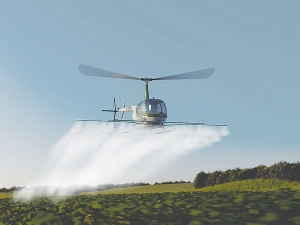Wairarapa’s Bradley Wadsworth blends farming and technology
Bradley Wadsworth lives on the family farm – Omega Station – in the Wairarapa about 30 minutes’ drive east from Masterton.
 Based around a full-sized, well-known Robinson R44 helicopter, the autonomous machine has a capacity of 500 litres.
Based around a full-sized, well-known Robinson R44 helicopter, the autonomous machine has a capacity of 500 litres.
While we are seeing more and more drones being used in New Zealand agriculture, we’re some way behind the US, where in places like the Midwest, the drones are certainly bigger than Texas.
Equipped with 33ft (10m) booms and a 110gal (500l) capacity tank, the new Sprayhawk drone is being classed as the biggest agri-spray drone on the market.
Designed and developed by Rotor Technologies, based in New Hampshire, USA, the new unmanned aerial vehicle (UAV), The Sprayhawk, has been released to market with a hefty price tag of $1.47 million.
Based around a full-sized, well-known Robinson R44 helicopter, and fully controlled by a two-man ground crew, the autonomous machine has a capacity of 500 litres matched to 10 metre booms and a capability of covering up to 100ha/hour, with a maximum take-off weight of 1133kg.
Powered by a Lycoming six-cylinder aviation engine that can help deliver a working speed of over 125km/h and a flight time of 50 minutes between refuelling, the Sprayhawk can take off and land vertically, then use autonomous spray path and terrain following algorithms, as well as camera and LIDAR sensor technology for detecting wires and avoiding obstacles.
Impressively, the Sprayhawk matches the spray speed and capacity of manned aircraft, while offering significantly lower operating costs and improved safety.
The first Sprayhawk production aircraft is currently undergoing ground testing ahead of delivery to an agricultural partner in the US Midwest later this year. The first batch of production Sprayhawks will be delivered to early-access partners throughout spring 2025 and are expected to begin commercial spraying operations in the 2025 corn season.
For 2025, the first production run will be limited to 15 aircraft, with customers receiving a “ready-to-spray” pack which includes the Sprayhawk UAV, a 110-gallon tank and 33-foot spray boom system, a helicopter transport trailer, and a ground control station. Rotor offers training, maintenance plans and regulatory support to customers to ensure seamless deployment in any agricultural setting.
A company source commented, “Many of the agricultural drones on the market today are unlikely to stand the test of time. The need for larger and more reliable aircraft is clear and our aggressive introductory pricing for the 2025 model year is designed to speed up adoption.”
Former Agriculture Minister and Otaki farmer Nathan Guy has been appointed New Zealand’s Special Agricultural Trade Envoy (SATE).
Alliance Group has commissioned a new heat pump system at its Mataura processing plant in Southland.
Fonterra has slashed another 50c off its milk price forecast as global milk flows shows no sign of easing.
Meat processors are hopeful that the additional 15% tariff on lamb exports to the US will also come off.
Fears of a serious early drought in Hawke’s Bay have been allayed – for the moment at least.
There was much theatre in the Beehive before the Government's new Resource Management Act (RMA) reform bills were introduced into Parliament last week.

OPINION: The release of the Natural Environment Bill and Planning Bill to replace the Resource Management Act is a red-letter day…
OPINION: Federated Farmers has launched a new campaign, swapping ‘The Twelve Days of Christmas’ for ‘The Twelve Pests of Christmas’ to…